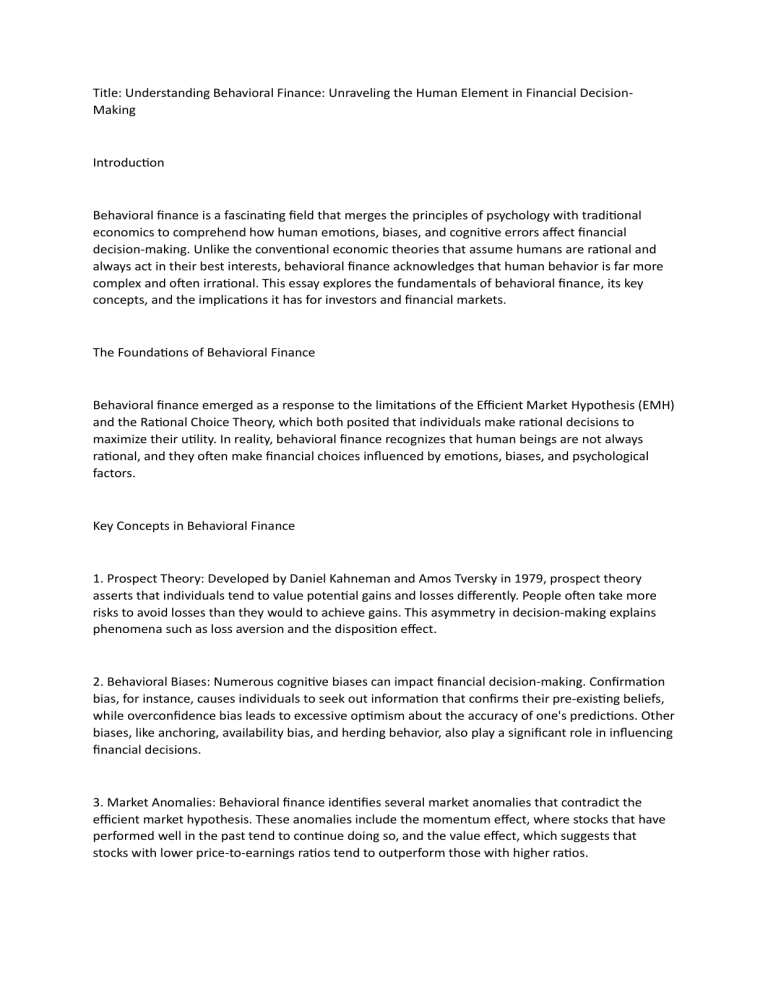
Title: Understanding Behavioral Finance: Unraveling the Human Element in Financial DecisionMaking Introduction Behavioral finance is a fascinating field that merges the principles of psychology with traditional economics to comprehend how human emotions, biases, and cognitive errors affect financial decision-making. Unlike the conventional economic theories that assume humans are rational and always act in their best interests, behavioral finance acknowledges that human behavior is far more complex and often irrational. This essay explores the fundamentals of behavioral finance, its key concepts, and the implications it has for investors and financial markets. The Foundations of Behavioral Finance Behavioral finance emerged as a response to the limitations of the Efficient Market Hypothesis (EMH) and the Rational Choice Theory, which both posited that individuals make rational decisions to maximize their utility. In reality, behavioral finance recognizes that human beings are not always rational, and they often make financial choices influenced by emotions, biases, and psychological factors. Key Concepts in Behavioral Finance 1. Prospect Theory: Developed by Daniel Kahneman and Amos Tversky in 1979, prospect theory asserts that individuals tend to value potential gains and losses differently. People often take more risks to avoid losses than they would to achieve gains. This asymmetry in decision-making explains phenomena such as loss aversion and the disposition effect. 2. Behavioral Biases: Numerous cognitive biases can impact financial decision-making. Confirmation bias, for instance, causes individuals to seek out information that confirms their pre-existing beliefs, while overconfidence bias leads to excessive optimism about the accuracy of one's predictions. Other biases, like anchoring, availability bias, and herding behavior, also play a significant role in influencing financial decisions. 3. Market Anomalies: Behavioral finance identifies several market anomalies that contradict the efficient market hypothesis. These anomalies include the momentum effect, where stocks that have performed well in the past tend to continue doing so, and the value effect, which suggests that stocks with lower price-to-earnings ratios tend to outperform those with higher ratios. Implications of Behavioral Finance 1. Investment Strategies: Investors can incorporate insights from behavioral finance into their strategies. Recognizing and mitigating cognitive biases, diversifying portfolios, and avoiding the herd mentality can improve investment outcomes. Additionally, value investing and momentum strategies have been devised based on behavioral principles. 2. Market Efficiency: Behavioral finance challenges the traditional view of market efficiency. It suggests that markets are not always perfectly efficient, and that anomalies persist due to irrational behavior. This has led to the rise of behavioral economists who study market inefficiencies and design strategies to exploit them. 3. Policy and Regulation: Policymakers and regulators have also embraced behavioral finance principles. For instance, nudging is a concept that leverages behavioral insights to encourage individuals to make better financial decisions, such as opting into retirement savings plans. 4. Risk Management: Understanding behavioral biases helps in developing risk management strategies. It enables financial professionals to assess their clients' risk tolerance more accurately, leading to better asset allocation decisions. Conclusion Behavioral finance provides a more holistic view of financial decision-making by acknowledging the complex and sometimes irrational nature of human behavior. It has become an essential component of modern finance, influencing investment strategies, market efficiency debates, and public policy. By recognizing the importance of psychological factors in financial choices, we can better navigate the complexities of the financial world and make more informed decisions that align with our long-term goals.



